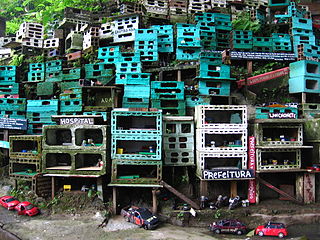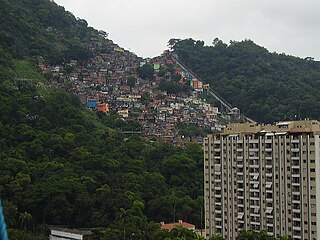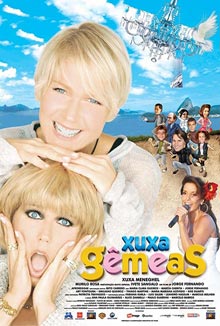Related Research Articles

Montevideo is the capital and largest city of Uruguay. According to the 2023 census, the city proper has a population of 1,302,954 in an area of 201 square kilometers (78 sq mi). Montevideo is situated on the southern coast of the country, on the northeastern bank of the Río de la Plata.

Favela is an umbrella name for several types of impoverished neighborhoods in Brazil. The term, which means slum or ghetto, was first used in the Slum of Providência in the center of Rio de Janeiro in the late 19th century, which was built by soldiers who had lived under the favela trees in Bahia and had nowhere to live following the Canudos War. Some of the last settlements were called bairros africanos. Over the years, many former enslaved Africans moved in. Even before the first favela came into being, poor citizens were pushed away from the city and forced to live in the far suburbs.

Itaqui is a municipality in Brazil, located in the southwestern part of the state of Rio Grande do Sul, close to the Argentinian border, between Uruguaiana and São Borja. It sits at a mean altitude of 57 meters (187 ft), by the Uruguay River. Its population is currently estimated at 37,489.
Funk carioca, also known as favela funk, in other parts of the world as baile funk and Brazilian funk, or even simply funk, is a Brazilian hip hop-influenced music genre from Rio de Janeiro, taking influences from musical styles such as Miami bass and freestyle.

Martín Sastre is a Uruguayan film director and contemporary media artist working with film, video, sculpture, photography and drawing.
Brígida Baltar was a Brazilian visual artist. Her work spanned across a wide range of mediums, including video, performance, installation, drawing, and sculpture. She was interested in capturing the ephemeral in her artwork.

Hélio Oiticica was a Brazilian visual artist, sculptor, painter, performance artist, and theorist best known for his participation in the Neo-Concrete Movement, for his innovative use of color, and for what he later termed "environmental art," which included Parangolés and Penetrables, like the famous Tropicália. Oiticica was also a filmmaker and writer.
The Iberoamerican Trilogy is a short film trilogy directed by Uruguayan media artist Martin Sastre between the years 2002 and 2004. The films are about a future period of human civilization defined as the Iberoamerican Era when Latin America becomes the central cultural power of the World after Hollywood collapsed, until the rising of Bolivia as a confederation, taking all the Americas as its own territory.
Bolivia, Confederation Next is a short film directed by Uruguayan media artist Martin Sastre in the year 2004 and the third part of his futuristic Iberoamerican Trilogy

The roots of Brazilian sculpture have been traced back to the late 16th century, emerging soon after the first settlements in the newly discovered land. Through the following century, most of the sculpture in Brazil was brought from Portugal and displayed Baroque features. The Baroque style would flourish within the religious culture of the country and would remain predominant until the first decades of the 19th century. In the 19th century, sculptural activity decreased, but it later revived when both the government and the public took a new interest in the art. Modernism fomented a period of intense research into a new language of sculpture, with great achievements, and the contemporary sculpture of Brazil enjoys worldwide respect.

The Morro da Babilônia is a hill in the Leme neighbourhood of Rio de Janeiro, separating Copacabana beach from Botafogo. It is home to a favela known by the same name, as well as the favela Chapéu Mangueira. Morro da Babilônia is an environmentally protected area.

Project Morrinho is a social and cultural project based out of the Favelas Cariocas and the Favela (Pereirão) in the Laranjeiras neighborhood of Rio de Janeiro, Brazil. Morrinho, which was started by local youth in 1997, is a 450m² model of the city constructed from bricks and other recycled materials. It began as a simple childhood game to escape the realities of violence and corruption that surrounded the teens and their community.

Favela Santa Marta is a favela located in the Botafogo and Laranjeiras part of the Morro Dona Marta, that is also divided with the neighborhoods of Flamengo, Cosme Velho and Silvestre, in the South Zone of Rio de Janeiro, Brazil. It has about 3,913 residents and 1,287 domiciles, with 500 wooden houses, 2,000 brick houses, 4 kindergartens, 3 bakeries, 2 sports fields, 1 block of a samba school, 3 military units and 1 small market. The favela is one of the steepest in the city, with an altitude of 352 metres (1,155 ft), approximately 45 degrees of inclination and occupies an area equivalent to 53,706 square metres (578,090 sq ft).

The Headquarters of the Bank of the Oriental Republic of Uruguay is the building that houses the main offices of the Banco de la República Oriental del Uruguay. It is located in Ciudad Vieja, Montevideo. The building, which was built in the neoclassical style, was designed by Italian architect Giovanni Veltroni and completed in 1938.
Portuguese Uruguayans are Uruguayans of full or partial Portuguese ancestry, many of whom are of Azorean descent.

Xuxa Gêmeas is a 2006 Brazilian romantic comedy children's film written by Flávio de Souza, Jorge Fernando and Patricia Travasso, directed by Fernando, produced by Globo Filmes, Diler & Associados, Warner Bros. Pictures and Xuxa Produçoes and distributed by 20th Century Fox and Warner Bros. Pictures. This is the last Xuxa film to be produced by Diler Trindade. Starring the Xuxa Meneghel with the participation of Ivete Sangalo, Murilo Rosa, Maria Clara Gueiros, Maria Mariana Azevedo, Eike Duarte, Ary Fontoura, Fabiana Karla, Thiago Martins.

Hilda López was a Uruguayan painter and sculptor. She was best known for her abstract, gestural paintings and drawings from the 1960s, as well as for her political activism following the 1973 Uruguayan coup d'état. López's work first came to public attention in the 1960s after exhibitions in Montevideo and the United States, and she soon became an influential name in Uruguay's Informalism movement. López represented Uruguay in the São Paulo Art Biennial, and her work is part of the collection of the National Museum of Visual Arts in Uruguay.

Mónica de Miranda is a Portuguese visual artist, photographer, filmmaker, and researcher of Angolan ancestry known for her artwork on socially inspired themes, including postcolonial issues of geography, history, and subjectivity related to Africa and its diaspora. Her media include photography, mixed media and video. De Miranda first became known for her photographic records of the ruins of modern hotels in post-war Angola, and their surrounding sociopolitical circumstances. Her photographic series, videos, short films, and installations have been internationally exhibited at art biennales, galleries, and museums, some of which keep her work in their permanent art collections. Her work has been reviewed in specialized art sources.

The armed conflict for control of the favelas in Greater Rio de Janeiro or simply Civil conflict for control of the favelas is an ongoing conflict between Brazilian militias, organized criminal groups Comando Vermelho, Amigos dos Amigos, Terceiro Comando Puro and the Brazilian state.
References
- ↑ Bravo, Issues 107-112. D'Avila Comunicações Ltda. 2006. p. 19.
- ↑ "Vídeo do artista Martín Sastre revive Lady Di em favela uruguaia". Terra (in Portuguese). August 24, 2005. Retrieved September 7, 2013.
- ↑ Ezabella, Fernanda (2008-08-24). "Vídeo do artista Martín Sastre revive Lady Di em favela uruguaia" (in Portuguese). UOL Entretenimento. Archived from the original on 2010-01-18. Retrieved 2009-04-09.
- ↑ "Lady Di vive en Uruguay" (in Spanish). infobae.com. 2007-04-02. Archived from the original on 2007-10-10. Retrieved 2009-04-09.